You have purchased a new gas boiler for a private house and it's time to take its place in the furnace. To do this, you can hire a specialized company or contact the appropriate service. But the cost of installation in this case will significantly hit the wallet, while there is an opportunity to reduce the cost of the process. Yes, some operations are only allowed to be performed by licensed organizations, but this is only half of the work, the rest can be handled independently. Here we will tell you about how to install a gas boiler in a private house from start to finish.
Where to begin?
Since the installation of new gas-using equipment requires compliance with certain rules, it is worth ordering all work requiring a license to the gas service:
- Issuance of technical specifications.
- Development of project documentation.
- Work on connection to the natural gas pipeline.
You can do the rest of the actions yourself. First, you need to obtain from the gas service technical conditions for the installation of gas equipment. Check them out or make a copy and immediately order project documentation from them. When it is ready, it will need to be approved by the gas service. As you might guess, this procedure is a pure formality, after its completion, a team will come to your home and install the gas boiler in terms of its connection to the fuel line, about which an appropriate act will be drawn up.
All that remains for you to do is to complete the piping and connection to the heating system, laying of electrical networks. Here it will be possible to save money, either by doing everything with your own hands, or with the help of familiar plumbers. The last stage is the final paperwork.
It's just short description one of the possible algorithms for solving the problem, but in fact, not everything is so simple, because gas boilers must be installed in compliance with regulatory requirements, it will not hurt to familiarize yourself with them at the stage of choosing a heat generator.
Boiler installation requirements
First of all, it is necessary to take into account all the requirements for the room where the heat source is supposed to be placed. The options are:
- kitchen;
- a room inside the house, adjacent to one of the outer walls and having windows;
- premises in the basement or basement;
- in the outer annex.
In the kitchen, installation standards allow you to place a floor-standing or wall-mounted unit with a heating capacity of up to 60 kW. Equipment with indicators from 60 to 150 kW can be installed in a separate room on any floor, and from 150 to 350 kW - only on the first or basement floor, in the basement or annex. At the same time, it is important to observe the dimensions of a separate room or an attached part, they cannot be less than prescribed in the standards. The minimum standard height of such a room is 2.5 m for any power within the specified limits.
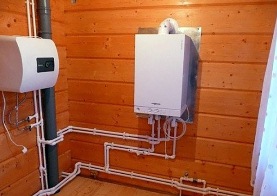
Note. The heat power values \u200b\u200bprescribed in the standards and affecting the boiler installation conditions are the total power of all units in the boiler room, including those working for the needs of hot water supply.
For heat generators with a capacity of up to 150 kW, in accordance with the standards, the smallest volume of the room for installing a gas boiler is 15 m3, in addition, for each kW of water heating equipment, 0.2 m3 is added to this volume. If the total indicator of all units exceeds 150 kW, then the dimensions of the room are not standardized. But the rules for the installation and safe operation of boilers are in force, according to which it is necessary to maintain technological gaps between the units and the walls of the room, they are taken for reasons of ease of maintenance and access to all systems in the boiler room. The dimensions of the passages in accordance with the rules are as follows:
- From the protruding part of the gas burner device to the wall on the front side of the heat generator - at least 1 m.
- If it is written in the operating instructions of the unit that it needs to be serviced from the side or behind, then you will have to maintain a passage width of 1.5 m, but when there is no such record, but you need to provide access to other equipment or fittings, then it is enough to make a clearance of 700 mm. In other cases, the requirements for installation are put forward in the documents for the product from the manufacturer.
- If it is planned to put 2 heat sources in the furnace, then you should not place them opposite each other, since you will have to provide a gap between the protruding parts of the burners of at least 2 m.
- Nothing can be laid through the passages at a height lower than 2 m.
For a kitchen where it is allowed to place not too powerful heating equipment (up to 60 kW), not the most stringent requirements are imposed on the installation of gas boilers. You just need to comply with the volume standard given above, and also provide air exchange in the amount of 3 times in 1 hour. Additionally, it is required to supply fresh air for fuel combustion, its consumption for each unit is indicated in technical characteristics... This standard is valid for all types of boiler houses.
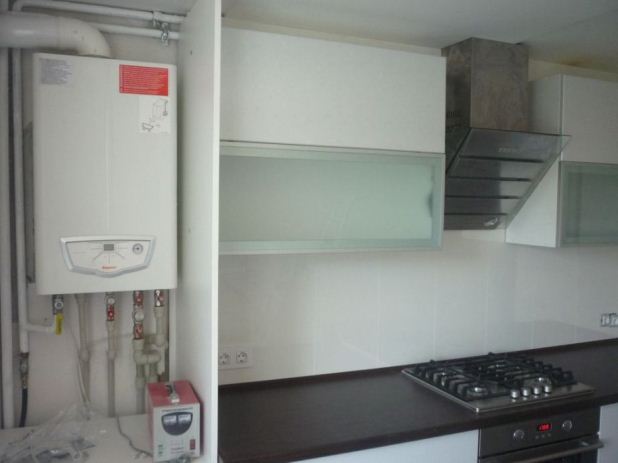
Note. For heat generators with a closed chamber, the installation standards for gas boilers are not forced to provide an air mixture for combustion, since they take air directly from the street through a coaxial chimney, which will be discussed below.
In the regulatory documents, it is proposed to organize ventilation for the boiler in the kitchen using an exhaust shaft and a supply grille built into the front door. The cross-section of this lattice is also standardized, its area cannot be less than 0.025 m2. In the same way, it is possible to arrange air exchange in separate furnaces. Difficulties with the supply of fresh air can arise in the basement or basement floors, it is possible that a special supply fan will need to be installed to meet the technical conditions.
In boiler rooms located on the first, basement floor or in an annex, window openings with a glazing area of \u200b\u200bat least 0.03 m2 are needed for each cubic meter of room volume. Requirements for fire resistance of walls, separate foundations and entrance doors are also put forward for the attached premises. In addition, the extension cannot be built on the front facade of the building, and during construction it is necessary to retreat from the nearest window or door 1 m horizontally.
It should be noted that the requirements for a gas boiler located in wooden house, are identical to the standards for buildings made of other materials, that is, the rules for the construction of boiler rooms are the same for all buildings.
Boiler installation work
When a suitable room has been selected and the project documentation has been completed for it, you can proceed with your own installation of the heat generator in place. To do this, you will need a gas boiler connection diagram in a private house, which must be present in the project. It shows the installation site, the distance to all enclosing structures and technical requirements to the production of work.
Often, the installation of floor-standing gas boilers requires a foundation. In many cases, it is not needed, for example, when a high-quality screed is arranged in the room, and the weight of the unit does not exceed 50 kg. If the weight of the equipment is more than this value, then you will have to prepare the base. To do this, it is necessary to destroy the existing screed, pour in a cushion of rubble and carefully tamp it. Then tie a mesh made of periodic profile reinforcement with a diameter of 8 to 12 mm, lay it on the finished base and pour concrete.

In order to withstand the technology of installing gas boilers, the dimensions of the foundation in the plan must exceed the dimensions of the equipment by 50 mm, and in height it is made protruding 50-100 mm above the level of the screed. Complete hardening of a concrete slab will take you at least 2 weeks, this must be taken into account when planning work.
Further, a fireproof gasket made of asbestos or metal is placed on top of the foundation and a heat generator is placed on it, adjusting the legs of the unit in such a way as to maintain a clear horizontal. After that, using the gas boiler installation scheme, it is connected to all engineering networks, except for the fuel line. This connection, as mentioned above, is carried out by a licensed organization.
To install a wall-mounted gas boiler in a private house, you need not a foundation, but a solid foundation in the form of an outer wall, which is able to withstand the weight of the unit. First of all, markings are made on it, showing where the heat generator itself will be suspended and where the chimney will come out. Then, using a punch, a through hole is drilled in this place, into which a metal sleeve is inserted.
There is no particular difficulty in hanging a wall-mounted gas boiler. If the action takes place in the kitchen in an apartment or house, it is necessary to take measures to protect the furniture from debris and then proceed with the fastening process. Difficulties can arise during the installation of heavy units, whose power reaches 120 kW; here you cannot do without an assistant.
Note. When the wall-mounted boiler is attached to a wall made of combustible material, a special bracket must be made to make a 45 mm gap between the wall surface and the rear panel of the heater. Also, a sheet of non-combustible material should be attached to the wall, which plays the role of a protective screen.
The last step is the piping of the gas boiler and the chimney device. Here it is necessary to compactly place taps and other fittings under the casing of the heat generator so that everything looks neat and at the same time it is possible to disassemble or change any element. Therefore, when the heating circuit in the house is made of polypropylene pipes, then it is better to use bronze taps and a sump, and plastic pipes connect via threaded adapters. In this regard, the installation of a double-circuit gas boiler is somewhat more complicated, where it will be necessary to lay pipes for hot water supply and correctly connect them to the corresponding nozzles.
Chimney requirements
In essence, the requirements for chimneys of floor and wall gas boilers are identical, the difference may be in the design of the flue itself. It depends on the device of the heat source:
- Heat generators with an open combustion chamber take air from the room and discharge the combustion products through a traditional natural draft chimney.
- Units equipped with a closed chamber draw in air from the street forcibly, using a fan, through a double-walled pipe, which simultaneously serves as a gas duct (coaxial chimney).

A traditional chimney for a gas boiler is installed in the thickness of the wall or suspended from the outside of the building. The cross-section of the outlet from the unit determines the diameter of the entire chimney, it should be the same size, or better - 20-50 mm larger. The horizontal section connecting the boiler to the chimney is ideally 1 m long, the maximum permissible length is 2 m.
Below the insertion point, a door is required for cleaning and internal inspection, and the blind end of the vertical pipe is equipped with a condensate drain system. When installing the chimney of a gas boiler, it must be remembered that it is not allowed to cover the exit of the pipe with umbrellas, deflectors, weather vane and so on. Only the restriction nozzle can be supplied in accordance with regulations.
![]()
Unlike traditional flue gas exhaust ducts, it is much easier to install a double-walled chimney for heat generators with a closed chamber. Having made a hole of the required diameter in the outer wall and built a metal sleeve into it, a coaxial chimney is installed, which is a horizontal double-walled pipe of a certain length. The only condition that must be met is a slight bias towards the smoke outlet. It is done so that the condensate formed in the air duct does not flow into the boiler.
Conclusion
So, doing the installation and piping of the boiler with your own hands is a difficult task, but quite feasible. It will take a lot of time and patience to complete all the documentation, but you yourself assembly work will take a maximum of 3-4 days, or even less. Here it is important to prepare well and purchase in advance all the missing elements of the strapping scheme, as well as fasteners.
1.
2.
3.
4.
5.
All owners of private real estate who plan to equip a heating and hot water supply system have heard that the installation and installation of gas boilers should be carried out by certified specialists. In practice, many firms have raised prices for the provision of such services so much that sometimes they reach half the cost of equipment. But in reality, a certificate is needed only for carrying out work on connecting to the gas main. But to connect a heating unit and power supply, to connect a pipeline for a coolant, you do not need special skills, it is only important to study the rules for installing a gas heating boiler.
Rules for arranging a room for a boiler room
Certain requirements are imposed on the premises where it is planned to install and connect a gas boiler, and they must be fulfilled, otherwise accidents cannot be avoided, as well as penalties. Gas is a flammable and explosive substance and therefore all safety regulations must be followed.According to the installation instructions for heating units, the installation of a single-circuit gas boiler, the power of which does not exceed 60 kW, is allowed in any room of the house. As for double-circuit models, it is forbidden to mount them in the kitchen. When the total power of the equipment does not exceed 150 kW, it is allowed to equip the room for it on any floor of the house. It is forbidden to install gas appliances in living rooms, bathrooms and bathrooms.
In the event that it became necessary to supply one apparatus or several heating units with a capacity of 150 - 350 kW, the rules for installing a gas boiler interpret that they can be located only on the first floor or in the basement. If the project provides for the installation of a heating device in the kitchen, the standard for its area requires changes. The volume of the furnace is calculated taking into account the fact that at least 0.2 m³ must fall on one kW of heating equipment.

- wall height - at least 2.5 meters;
- availability of comfortable access to the device for servicing it and auxiliary equipment;
- room volume - not less than 15 m³;
- doorway width - at least 80 centimeters;
- the limiting degree of fire resistance - from 0.75 hours or more;
- providing access to the combustion room of natural light;
- the presence of a window, the minimum area of \u200b\u200bwhich is calculated taking into account the fact that 1 m³the volume of the room requires 0.03 m² of the window opening area;
- it is necessary to have a ventilation grill located at the bottom of the door or wall leading to the next room. Its area is calculated by the following formula: 8 cm² / per 1 kW of unit power;
- be sure to have a gas analyzer and a valve that automatically shuts off the gas supply in the event of a leak.
Installation of a chimney for a gas boiler
An important point in the safe functioning of a gas boiler is the presence of a chimney. Both a malfunction of the device and its incorrect operation can end in tragedy. Most models of modern gas heating equipment are equipped with automation, which, when the draft in the chimney deteriorates, stops the fuel supply.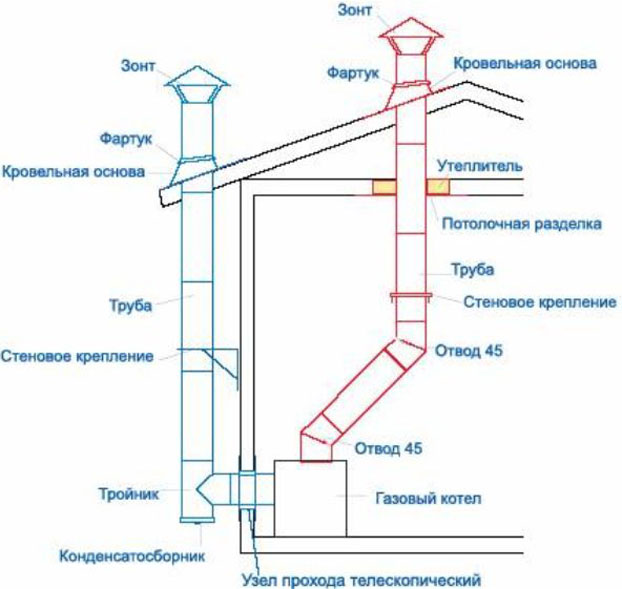
When buying a gas boiler, you need to make sure that the products are certified, otherwise difficulties will arise when registering the device. You should also check the serial number and the parameters of the unit indicated in the documents attached to it with those on the inner surface of the door.
When gas heating boilers are installed, the installation begins with flushing all the internal pipes, for which the transport plugs are removed and water is passed through the device under low pressure. The fact is that during the assembly process at the factory, debris could get into the tubes, which must be removed.
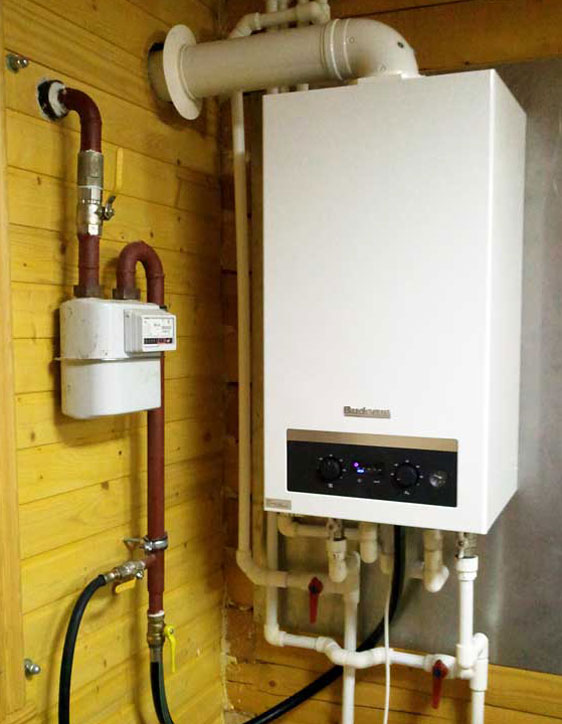
The wall surface where the boiler will be located must be made of non-combustible materials. If this is not the case, then a 3mm layer of heat resistant coating should be placed on the wall. The rules for installing a gas boiler assume that the device is placed at a distance of at least 45 millimeters from the wall.
After that, the installation of the heating unit is started: the sequence of actions is as follows:
- At a height of 80 to 160 centimeters from flooring fasten the mounting strips, and to them - the boiler. Its location is checked using a level. The technical conditions for the installation of a gas boiler regulate that it must be placed at a distance of at least 20 centimeters from other devices operating on gas or electricity. There should be no flammable materials in the immediate vicinity.
- A filter should be installed on the inlet pipe, which will prevent clogging of the heat exchanger. On both sides of it, shut-off valves are mounted. As a result, the filter can be removed and cleaned without draining the water from the system.
- Then, the chimney of the gas boiler is installed and the presence of draft is confirmed. By the way, most modern suspended units are those that do not have a chimney. The combustion products are removed by means of a small fan, since no strong draft is required in the chimney.
- After that, the gas line is connected. This stage performed only by certified specialists.
- The installation of a gas boiler in the kitchen or in a room specially designated for this appliance is completed by connecting the appliance to the mains. If the operation of the heating unit depends on electricity, the power circuit is equipped with an overheating and short circuit protection circuit breaker.
Installation of a floor-standing gas boiler: instruction
The floor-standing gas equipment shown in the photo is more powerful than the wall-mounted equipment and is designed to heat a large area. Often a private house has several floors and in order to heat it before choosing heating equipment, you should imagine the location of the pipes in the boiler room. It is necessary to know this so that the boiler nozzles are located on the pipe inlet side.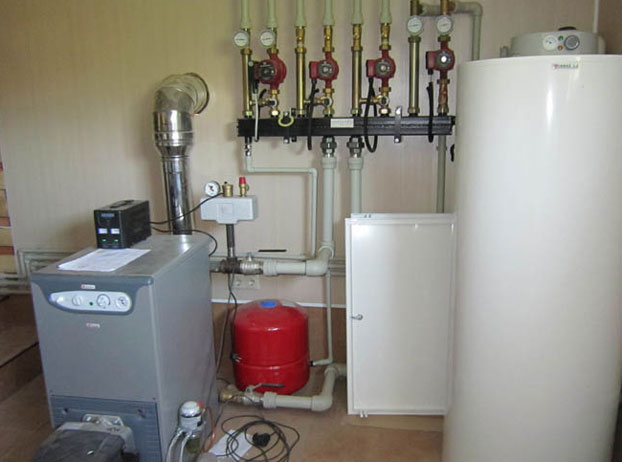
- Since floor-standing models of heating appliances are heavy, they need a durable and solid foundation... On a solid wooden floor, it will be enough to lay a sheet of galvanized iron, the size of which exceeds the area of \u200b\u200bthe base of the device (for more details: ""). It should protrude about 30 centimeters from the front of the boiler. It is necessary to install the heating unit as evenly as possible, if necessary, placing a piece of solid non-combustible material, for example, a plastic ruler, under the legs.
- If the appliance does not work on forced draft, it must be connected to the chimney.Then the boiler is connected to the heating system. After the outlet through which it is filled, a hard filter should be installed in front of the return pipe inlet to prevent clogging of the heat exchanger.
- Double-circuit devices must not only be embedded in the heating structure, but also connected to a cold water source. When a tap is made into the water supply, it should be placed closer to the place where the pipeline enters the building. If it is not possible to do this, then the tie-in is done before the pipe branching. Thus, it is possible to ensure the highest pressure for the cold heat carrier in the unit and an uninterrupted supply of high pressure gas. Then a pipe for heated water is connected to the corresponding branch pipe.
- The rules for installing a gas boiler assume that the installation is carried out in such a way that, if necessary, the device can be easily dismantled. For this purpose, valves are installed on each incoming or outgoing pipe from the device, allowing it to be removed without discharging water from the heating structure. This point is especially important for systems operating on purified water that has undergone special treatment.
- Now it remains only to connect the heating unit to the gas pipeline. The connection must be made exclusively with a steel pipe.
- A specialist from Gorgaz must check the quality of the work done, sign the commissioning certificate of the boiler, and only then is it allowed to open the valve coming from the gas main. Now you can enjoy the warmth and comfort in own home and, if the work was done independently, enjoy the savings.
We have all heard more than once that the installation of gas boilers, as well as other gas appliances, should be carried out by certified specialists of gas enterprises. Unfortunately, using this rule, many firms have inflated prices for their services so much that the cost of installation sometimes reaches half the cost of the equipment itself. But in fact, a certificate is required only for work on a gas pipeline, and installing a boiler, supplying water, coolant and electricity (if the device is volatile) do not require any special skills.
A number of strict requirements are imposed on the room in which the gas boiler will be installed, failure to comply with which can lead not only to significant penalties, but also to accidents. Remember that gas is extremely flammable and explosive and should be handled with extreme caution.
Important! A single-circuit boiler with a capacity of up to 60 kW can be installed in any of the rooms of the house. Installation of double-circuit boilers in the kitchen is prohibited.
A room for equipment, the total power of which does not exceed 150 kW, can be located on any floor of the building.
Important! Installation of gas equipment in living rooms, bathroom and toilet is prohibited.
If you need to install a more powerful boiler or several devices with a capacity from 150 kW to 350 kW, this can only be done on the first or basement floor. In addition, the installation of a heating boiler in the kitchen entails a change in the standards for the area of \u200b\u200bthe room - the volume of the room must be calculated based on the fact that for 1 kW of device power, there should be 0.2 m³.
The boiler room must have the following characteristics:
- Ceiling height - not less than 2.5 m.
- Convenient access and maintenance of all devices and accessories.
- Volume - not less than 15 m³.
- The fire resistance of the walls is at least 0.75 hours.
- The norms for the installation of gas boilers provide for access to the natural light boiler room.
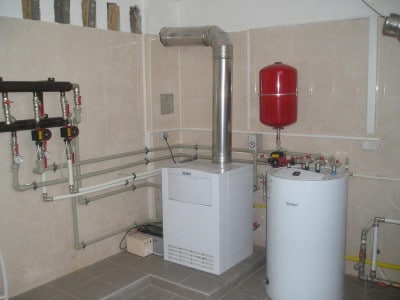
Boiler room - room for the installation of heating equipment
- A window, the minimum area of \u200b\u200bwhich must be calculated on the basis that 0.03 m² of window area should fall on 1m3 of the room volume.
- Ventilation grill at the bottom of a door or wall to an adjacent room. Its area can be calculated based on the following formula 8 cm² / 1 kW of boiler output.
- Door width at least 80 cm.
- The presence in the room of a gas analyzer and a valve that automatically shuts off the gas supply in the event of a leak.
Boiler chimney installation
Another important element of the safe operation of gas equipment is the chimney. Its malfunction or improper operation can lead to tragedy. Fortunately, most modern heating equipment is equipped with an automatic device that stops the gas supply in the event of a deterioration in the draft in the chimney.
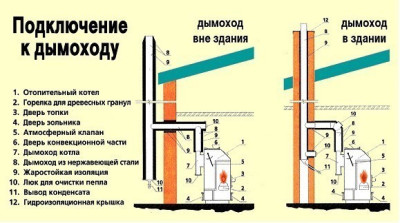
Connecting the boiler to the chimney must comply with all safety rules and it is better to entrust this work to professionals!
Basic requirements for the chimney:
- The diameter of the chimney cannot be less than that specified in the instructions for the boiler.
- The chimney section must not be less than the boiler chimney section.
- The chimney should rise above the roof ridge by at least half a meter.
- For gas equipment, cylindrical chimneys are recommended, made of metal - black or stainless steel - with a hole for cleaning.
- The rules for installing gas boilers prohibit the presence of more than three turns or bends of the pipe on the path of combustion products, and the segment connecting the device to the chimney should not be longer than 25 cm.
Required documents
Before proceeding with the installation of gas equipment, it is necessary to obtain a number of permits and approvals. First of all, you need to conclude an agreement on the supply of natural gas to housing construction and receive a project for gasification of a building and installation of gas equipment, developed and approved by the employees of the gas supply company. Now you can start installing the boiler and installing the heating pipes (if they are not already there).
Features of installing the wall option
Preparation for the installation of such equipment should be started at the stage of its purchase. Be sure to check the complete set of the device, see if it includes fasteners. If not, get them right away.
Important! When buying a gas boiler, make sure that it is certified. Otherwise, you may have problems registering the device.
Compare the boiler serial number and characteristics stated in the accompanying documents with those printed on the inside of the door.
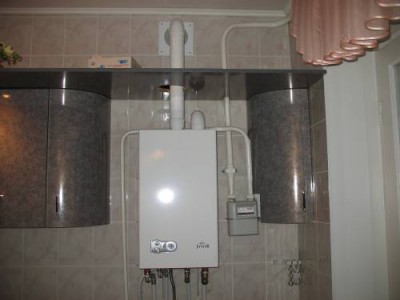
An example of a competent installation of a wall-mounted boiler in a kitchen
Before starting the installation of a wall-mounted gas boiler, it is necessary to flush all internal pipes. To do this, remove the transport seals and pass water under a slight pressure through the boiler. During assembly, small debris could get into the tubes, it must be removed.
The wall on which you plan to hang the boiler must be made of non-combustible material. If this is not the case in your case, it is necessary to lay a layer of heat-resistant coating on it, at least 3 mm thick, and fix the boiler at a distance of 45 mm from the wall.
Now you can start editing:
At a height of 0.8 - 1.6 m from the floor, we fasten the mounting strips, and to them the boiler. We check its location by level.
Important! The boiler must be installed at least 20 cm away from other gas or electrical appliances. There should be no flammable materials in the immediate vicinity.
A filter must be installed on the water supply pipe to help prevent clogging of the heat exchanger. We install shut-off valves on both sides of the filter. This is necessary so that you can replace or clean it without draining the water from the system.
We install the gas boiler flue and check the presence of draft (if required by the design of the device). Most of the modern suspended boilers belong to the so-called "non-chimney". That is, the combustion products are removed using a small fan. In this case, the presence of a strong draft in the chimney is not necessary.
We proceed to connect the gas. Here you cannot do without the involvement of specialists. The fact is that gas supply is allowed only with the use of metal pipe through a special drive or "American".
The installation of wall-mounted gas boilers is completed by connecting the device to the mains. If the boiler is volatile, its power supply circuit must be equipped with an overheating and short-circuit protection circuit breaker.
Important! Remember that only an employee of the gas industry has the right to open the gas valve and put the boiler into operation after checking the quality of its installation and the compliance of the boiler location with existing rules and regulations.
How to install a floor standing boiler?
Such equipment, as a rule, is more powerful than wall-mounted boilers and is intended for heating a sufficiently large area. Often, the installation of a boiler in a private house is associated with the need to distribute the coolant over several floors. And again it all starts at the purchase stage. When choosing a floor-standing boiler, it is important to be clear about the location of the pipes in your boiler room. This is necessary so that the boiler nozzles are on the same side as the pipe inlets.

An example of installing a floor-standing boiler in a boiler room. Now he supplies the whole house with hot water.
Considering the rather significant weight of the floor boiler, it is necessary to provide it with a solid base. If the floor in your boiler room is wooden, but strong enough, it is not necessary to pour a concrete screed under the boiler. It is enough to lay a sheet of galvanized iron, slightly larger than the base of the boiler. On the sides, it may coincide with the dimensions of the device, and on the front side it should protrude at least 30 cm.
Do-it-yourself boiler installation requires attention and care. Be sure to check its location with a level and set it as even as possible. To do this, under one of the legs, you can put a solid, non-combustible material, for example, pieces of a plastic ruler.
Connect the boiler to the chimney, if your appliance is not equipped with a forced draft, be sure to check the draft in the chimney.
Connect the boiler to an indoor heating system. Install a hard filter before the inlet of the return pipe, but after the outlet to fill the system. This will help prevent premature clogging of the heat exchanger.
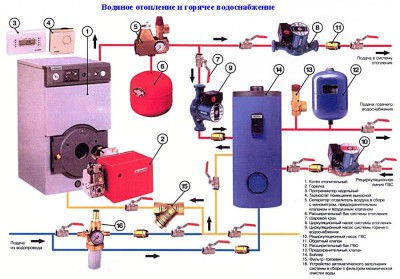
Features of connecting the boiler to the heating system - click to enlarge
A double-circuit boiler, in addition to being connected to the heating system, also requires a connection to the cold water supply. When making a tap into the water supply to connect to the boiler, try to keep it as close as possible to the place where the pipe enters the house. If for some reason it does not work out, then place the insert before the pipe branches. This ensures the highest cold water pressure in the boiler and uninterrupted hot water supply. Now connect the hot water pipe to the corresponding socket.
Important! The installation of gas heating boilers should be carried out in such a way that at any time the device can be easily removed. For this, valves must be installed on each pipe entering or leaving the boiler, which will allow dismantling the boiler without discharging water from the heating system. This is especially true for systems operating on chemically treated water.
It remains only to connect the boiler to the gas pipeline. As in the case of a wall-mounted boiler, this only needs to be done steel pipe... The gas valve can only be opened with the permission of a specialist who will check the quality of the work performed and sign the boiler commissioning certificate.
As a rule, observing all the requirements for the installation of gas boilers, home craftsmen can do the job in just a few hours. Another couple of days is spent waiting for the inspector from Gorgaz. And when the documents are signed and the gas valve is solemnly opened, you can enjoy the warmth and enjoy the job well done and the money saved.
1.
2.
3.
4.
About the arrangement of an autonomous gas heating system not only the owners of private households, but also apartments located in high-rise buildings, new buildings, are thinking. Only the design of the heat supply, which provides for the installation of a floor-standing gas boiler or a hinged heating unit, is capable of providing a comfortable stay. At the same time, autonomous heating will cost less than the services of centralized heat supply.
Before proceeding, you will need to obtain a special permit, but the main thing is to remember that the safety of people in the house depends on how correctly the work is done. All homeowners should be aware that independent device a floor-standing gas boiler is a responsible and complex matter, and obtaining an appropriate permit is a mandatory procedure.
It is possible to undertake the installation of a gas floor heating unit only on condition that there are financial possibilities to purchase a double-circuit boiler with a boiler and automatic regulation. You will also need a room that allows you to place a gas floor boiler there in accordance with the technical conditions.
Floor standing gas boiler device
It is advisable to entrust the installation of a floor-standing gas boiler to certified specialists of technical centers specializing in the provision of this type of service, since then they will draw up all the required documents, prepare the premises accordingly and give a guarantee for the types of work performed.If we consider the device of the simplest gas boiler, then it is simple: a gas burner and a heat exchanger. It will not be difficult to connect water, gas, chimney and, if necessary, power supply to the device. The main requirement: to issue all the necessary permits, otherwise penalties cannot be avoided.
Good choice for your own home is a double-circuit heater with a boiler and a set of automation. In this type, there is an automatic system equipped with a microprocessor and a double thermostat, due to which the air temperature outside and in the house is monitored, and according to the parameters of the set settings, when the residents are absent, the temperature regime is reduced to a sanitary minimum.
In such a boiler, the gas consumption is somewhere 30-70% less than in devices with manual or semi-automatic regulation. But such heating units still have a serious drawback - in the absence of power supply, the automation does not work and the boiler operates in the minimum heating mode. To avoid an interruption in the heat supply of the house, it will be necessary to organize an emergency power supply, which will lead to additional costs.

Features of installation of a floor-standing gas boiler
A gas boiler, regardless of whether a floor or wall model, should be installed in accordance with the rules and regulations:- the installation of a floor-standing gas boiler is carried out in a separate room, which is called a furnace or boiler room, with an area of \u200b\u200bat least 4 "squares";
- ceiling height - from 2.5 meters;
- the volume of the room should be more than 8 m³ with a heating unit capacity of up to 30 kW, 13.5 m³ at 31 - 60 kW and 15 m³ at 61 - 200 kW;
- must have an opening window;
- the width of the door in the boiler room cannot be less than 80 centimeters;
- the finishing of the furnace must be carried out using non-combustible materials;
- the presence of a raised floor or false ceiling in the room is unacceptable;
- it is imperative to ensure the flow of air entering through a non-closing air duct, the cross section of which is 8 cm² per 1 kW of unit power.
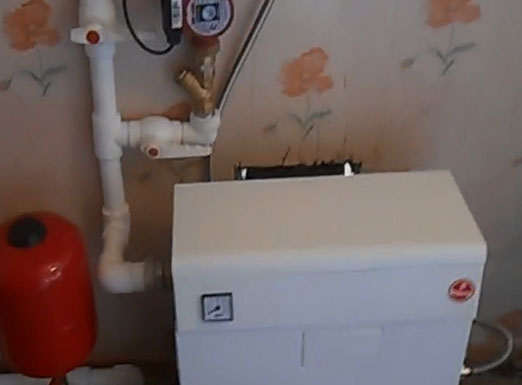
If the boiler is equipped with a closed combustion chamber, then the volume of the combustion chamber is not subject to standardization. Regardless of the boiler model, the rules and requirements must be observed.
The exhaust of a heating unit, when a connection diagram for a floor-standing gas boiler or a wall-mounted one is being developed, is taken out into a separate gas duct (read: ""). It is forbidden to use ventilation ducts for such purposes, since combustion products can penetrate into other rooms of the house, and in apartments of multi-storey buildings - to neighbors.
Other requirements include:
- compliance with the length of the horizontal section of the gas duct within the boiler room - no more than 3 meters. The angles of rotation cannot be more than 3. The flue must have a vertical outlet that rises above the ridge of the roof or above the gable of a flat roof by at least one meter. When using, only solid materials that are resistant to chemical and thermal influences should be used, since when the combustion products cool down, they form aggressive substances. Laminated materials such as asbestos-cement pipes can be used, but if they will be located more than 5 meters from the exhaust pipe;
- before installing a floor-standing gas boiler, it is necessary that the boiler room is properly prepared (in more detail: ""). The space in front of the unit is left free. A durable non-combustible metal sheet measuring 1 by 1 meter is laid on the floor under the heating unit. Asbestos cement cannot be used, since neither firefighters nor gas workers recognize it - it wears out after a while, and besides sanitary standards it is prohibited to keep materials containing asbestos in a residential area;
- in the boiler room there can be no places like cavities where combustion products or a gas mixture dangerous to human life can accumulate. In the event that a gas appliance is planned to be used to heat a house, gas workers will necessarily check the condition of the heating structure in an apartment or house. On horizontal sections, pipes should be located at a slope that does not exceed 5 millimeters per running meter in the direction of movement of the coolant. At the highest point of the heating system, you should install expansion tank and an air valve. Heating structure must be able to withstand the pressure test under a load of 1.8 bar.
Installation of even the simplest model is not allowed in the following cases:
- if the apartment is located in apartment buildingwhere there is no main gas duct;
- when the kitchen has a false ceiling, which residents do not want to clean, or a capital mezzanine. If the bottom of the mezzanine is made of cardboard or wood, it is easy to dismantle it.

In the event that the apartment is not privatized, only a hot-water boiler can be installed in it, since a separate boiler room is required for the gas appliance, which means redevelopment, which only homeowners have the right to do.
Any boiler is allowed to be installed in your own house, because the combustion room can be located outside the building. It is advisable that the boiler room is located outside the building, then the employees of the supervisory authorities will have less reason to make a remark and conduct inspections. In a separate annex, it is allowed to install a high-power floor-standing gas boiler, which allows heating not only living rooms, but also utility rooms.
For small households optimal solution is the installation of a wall-mounted boiler, since it does not require a brick or concrete pallet with 50-cm sides, as for a floor-standing heating unit.
Preparing to install a floor standing boiler
Before connecting a floor-standing gas boiler, you need to prepare tools and materials. You will also need to study the installation instructions for the unit and the operating manual.From materials and tools you need to have at hand:
- cement and sand;
- shovel;
- container for solution preparation;
- drill;
- a hammer;
- bolts and nails;
- wooden edging;
- pipes for the gas duct.
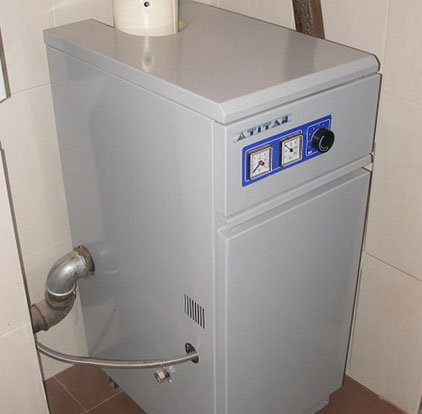
In apartments located in multi-storey buildings or in individual buildings, boilers with a closed combustion chamber are installed, a coaxial chimney is led out to the street through the wall of the room. The hole for the flue, depending on the boiler model, is located either on its rear wall or on the top panel. As a rule, it is located at the back and thus the chimney can be easily led out through the wall.
Installation of a floor-standing gas boiler
When the base is prepared, the appliance is placed on it so that the distance between the wall and the back of the boiler allows the equipment to be serviced and inspected. Then they mark the place of the chimney. According to the rules and requirements, the chimney pipe is placed aside at a distance of 60 centimeters or more from the window opening. Such requirements are explained by the need to prevent exhaust gases from getting back into the room.In private houses, the boiler should be installed in a special recess made below the floor level with a depth of 30 centimeters. A concrete screed is made at the bottom of the pocket, and its walls are plastered and lined with non-combustible material.
An example of installing a floor-standing gas boiler in the video:
The owners of suburban real estate are often forced to solve the issues of improvement, which are not faced by the townspeople. In particular, the issue of heating organization. If it is possible to connect the building to the main gas pipeline, then the problem in a private house can be solved quite simply. Consider how the installation of a gas boiler should take place.
The main element autonomous system heating is a gas boiler. The work is controlled automatically, when the sensor is triggered, the burner is turned on and off. So that the heating equipment does not require repairs every month and is completely safe, you need to know and follow the rules for installing a gas boiler.
Classification
The modern market offers a wide range of gas heating units with automatic (using a sensor) and manual control. They can be classified according to several criteria:
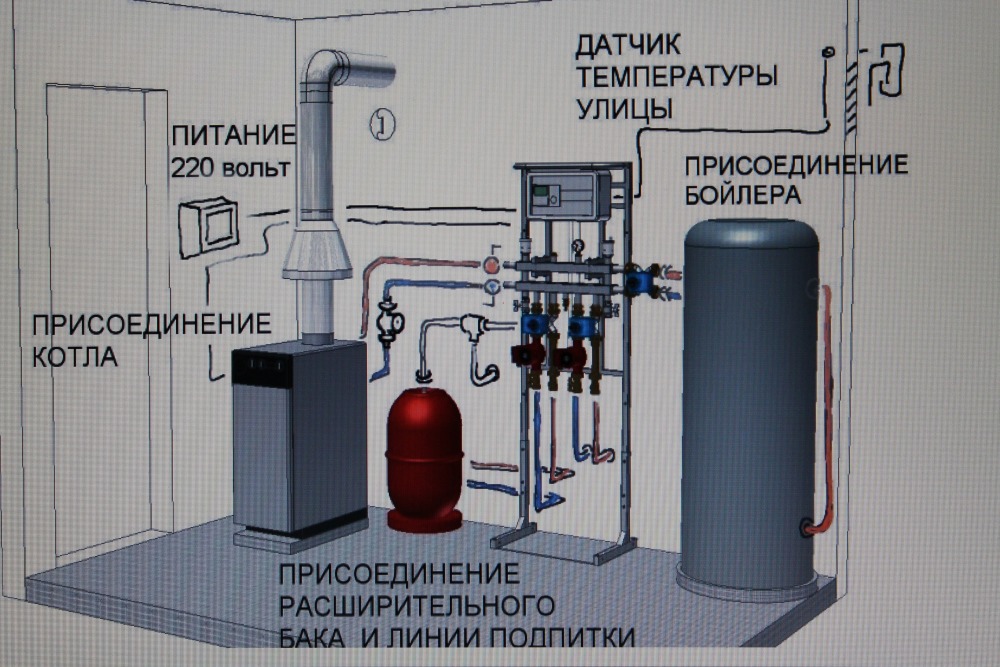
Where can a boiler be installed in the house?
The basic requirements for the installation of gas heating equipment are formulated in regulatory documents. In them, you can find the requirements for the introduction of a gas main into the house and for the room in which it is planned to install the heating unit.
Advice! The basic requirements for the installation and operation of gas heating units must be strictly observed, the safety of the residents depends on it.
It is impossible to completely install a gas boiler with your own hands. It will be necessary to contact specialists to develop a full-fledged project, and the launch of a heating system equipped with a gas boiler in a private house is allowed only after the special services draw up an acceptance certificate.
Seat selection
The choice of the place where the heating unit can be installed depends on the type of boiler. So, floor-standing units, the power of which exceeds 150 kW, can be installed in an isolated room located on the lower (basement) floor or in the basement. Basic requirements for the room used:
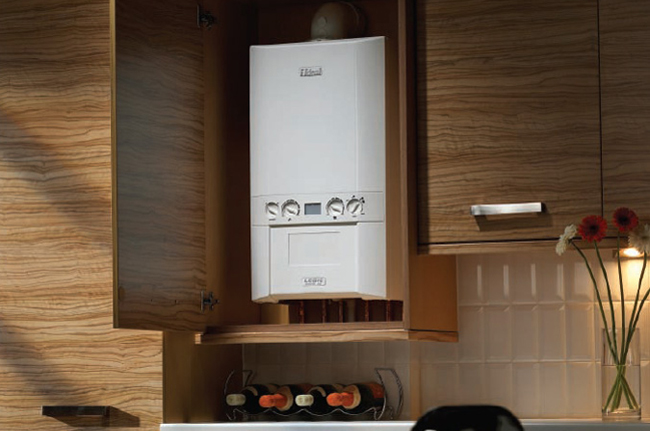
If you plan to install a wall-mounted gas boiler, then the requirements for the room are less stringent. However, the place in which the heating unit will be installed in a private house cannot be chosen at will. Consider where the boiler can be installed in the house and what room requirements must be met:
- Living rooms. This option is categorically unacceptable, the requirements clearly indicate that the installation room should be non-residential, these conditions are strictly prohibited to violate.
- Bathroom. As a rule, it is not possible to coordinate the installation of a heating boiler in the bathroom. The fact is that the microclimate conditions in this room have a bad effect on the automation systems and can lead to the failure of one or another sensor, and repairing the electronics is not cheap.
- Kitchen. When installing a unit with a capacity of up to 60 kW, it is not difficult to obtain a permit for installation in the kitchen.
Preparatory stage
Before proceeding with the installation of a floor-standing or wall-mounted unit, you must:

The requirements specified in SNiP are parameters that must be strictly observed during the installation process. So, in order to fulfill the requirements for the room, sometimes it is necessary to carry out preparatory repairs.
Smoke removal device
An indispensable condition for the operation and safe operation of a gas boiler is the presence of traction. Modern models of boilers are equipped with automation, due to which, when the draft deteriorates, the sensor is triggered and the gas supply stops.
When installing a unit with an atmospheric burner, to provide traction, a complete chimney system and a pipe outlet to the roof are required. If a unit with a closed turbo-type furnace is purchased, then a coaxial chimney is installed to create normal draft, which is discharged through outer wall.
Advice! As a rule, elements for assembling a coaxial chimney are supplied with the boiler.
Basic requirements for chimneys to ensure good draft and stable operation of the boiler:
- to create a normal draft and exclude the ingress of gas combustion products into the premises, it is important to ensure that the cross section of the boiler chimney is not larger than the diameter of the chimney;
- the chimney should have a minimum of turns, since the bends of the smoke exhaust duct lead to a deterioration in draft. No more than three turns are allowed;
- long horizontal sections of the chimney also contribute to a deterioration in draft, the length of the section connecting the unit with the chimney should not exceed 25 cm;
- when constructing a chimney, it is necessary to provide for the presence of revisions that will allow for repairs and cleaning;
- if the pipe is brought out to the roof, then it must rise at least half a meter above the ridge, only in this case normal traction can be achieved;
- for the manufacture of a chimney, it is best to use stainless steel; when using galvanized, chimney repairs will need to be done every 5-6 years.
Boiler installation
After all the conditions for installation are met, the boiler can be installed.
Installing the wall model
The work goes like this:
- the boiler is mounted on an external wall made of non-combustible material;
Advice! If the wall is wooden, then a fire-resistant coating is installed on it, and the boiler itself is mounted on a bracket at a distance of at least 4 cm from the wall.
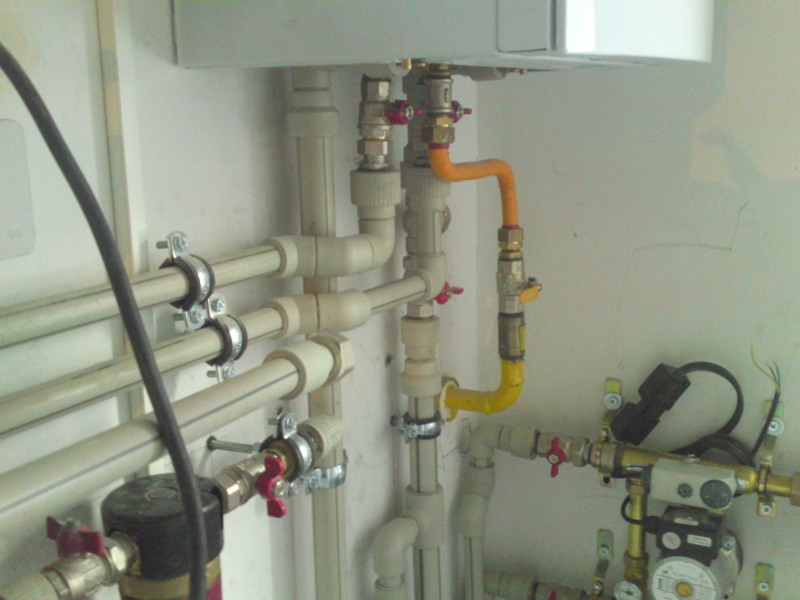
Floor standing unit installation
When installing a floor-standing boiler, you must first prepare a pedestal from a concrete screed covered with a steel sheet. The boiler itself is installed so that the load on all supports is uniform, the correct installation is checked by a level. If this condition is not met, the heating equipment will soon need repair. 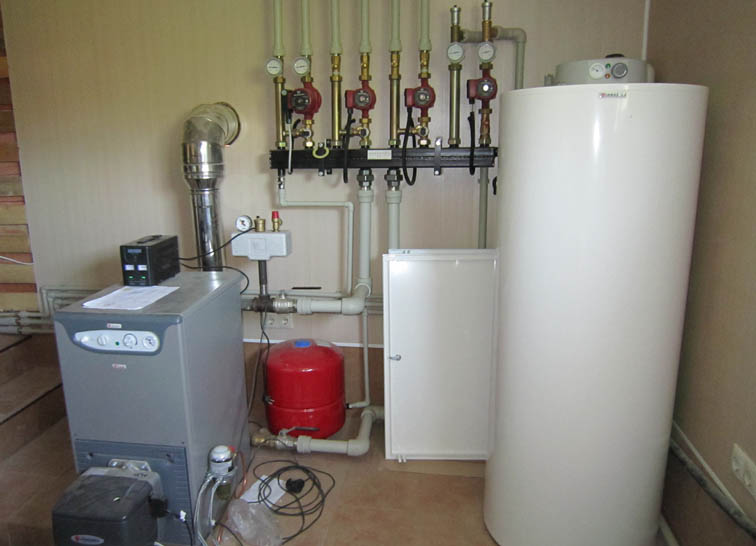
The equipment is connected to the chimney, then the pipes of the in-house heating system are connected. When installing a double-circuit boiler, tap water is supplied. The electrical part is connected, including the emergency shutdown sensor. Connection to the gas pipeline and start-up is carried out by specialists.
So, installing gas boilers is not easy. It is important to choose the right heating unit, to correctly determine the place of its installation, taking into account all the requirements of fire and gas safety. The most important part of the work is carried out by specialists, and a training video will help in installing and connecting the boiler



